 Modern gardeners have expanse - each vegetable has a dozen new varieties, choose any, grow, try! Each has its own characteristics, its own taste and of course, requires special care. For example, if we talk about sort of tomatoes, Japanese Truffle Tomato and its characterization and description show its uniqueness.
Modern gardeners have expanse - each vegetable has a dozen new varieties, choose any, grow, try! Each has its own characteristics, its own taste and of course, requires special care. For example, if we talk about sort of tomatoes, Japanese Truffle Tomato and its characterization and description show its uniqueness.
Grade characteristics
Probably rarely some garden or garden does not decorate tomatoes. Breeders of many countries are constantly developing new varieties, trying to make them better. In order not to be afraid of pests, outwardly pleasing to the eye, even the most severe cooks and gourmets liked the taste. And of course, so that care for them does not later fly into the penny for gardeners, large producers.
After all, a good variety is a profitable product. It is interesting that black truffle tomatoes are a fairly new variety for Russia, although Western vegetable growers themselves are sure that their homeland is Russia. Why such a strange name? It’s enough to look at the unusual shape. Such tomatoes are difficult to confuse with others. Mistresses like him for his good taste, attractive appearance.
Japanese red truffle is classified as an indeterminate variety. It really is not famous for its high productivity, somewhere around 2-4 kg from a bush. The variety itself is mid-season; it has a ripening period of 110 to 120 days.
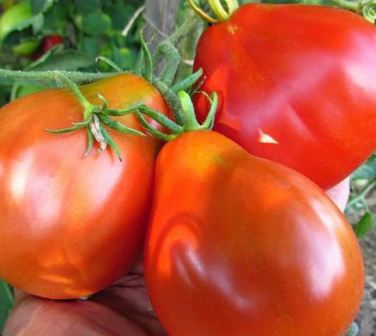
Bushes are high, if planted on a good, open ground, they can even reach 1.5, in a greenhouse all 2 m. They require mandatory tying with pinching.
Fruit
Tomatoes of this variety have several varieties inside, they are determined externally, by color:
• tomato Japanese truffle and pink - a delicate, pink hue;
• Japanese truffle tomato and black - a beautiful dark color, black or dark purple, dark blue fruits;
• truffle tomato and yellow - pear-shaped, warm fruits of yellow hues;
• red truffle - the most common;
• Japanese Truffle Orange.
These varieties only have different colors and may have a slightly different taste. So tomatoes come out 100-200 grams, pear-shaped. If you carefully try the taste, then the yellow (golden) truffle is more sweet, it is often eaten just like a fruit, without processing or slicing for salad.

The peel of the fruit is quite dense, the pulp is also, this makes them ready for long transportation, storage. Like black or yellow, even red truffle can be safely preserved, and eat fresh. Many gardeners try not to separate and immediately grow all varieties of varieties, then the tomato sector is more like a rainbow. Then if you canned several different tomatoes at once, the jars will have a beautiful combination in both color and taste.
Recommended:Tomato "Mazarin": reviews and photos
The shape is really pear-shaped, elongated, downward wide, narrower from above. Truffle yield is not striking in quantity, but experienced gardeners try to squeeze to the maximum. The peculiar shape of the fruit immediately produces a variety in any photo.
Recommendations
It’s not enough just to study the description of the variety if you want to grow Japanese Truffle. After all, it says only the shape, size, general characteristic of taste. Only the efforts of the gardener to grow will depend on how fruitful the year for a tomato will turn out. Here are some basic breeding tips:
"Japanese Truffle" needs to be grown when there are 1-2 stems. Then pinch so that in the end on the stem there are about 5-6 whole brushes left. Each brush then gives 5-7 fruits. According to the opinion of more experienced gardeners who have been engaged in truffle planting for several years now, the bush gives about 2-3 separate brushes, and the remaining fruits should be removed immediately while they are technically mature.
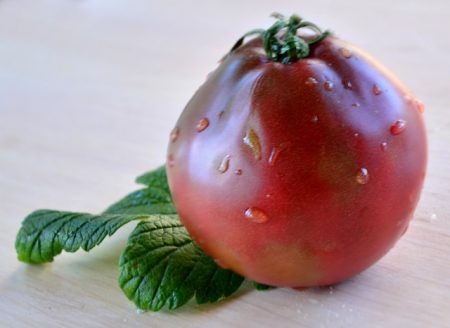
When choosing a place for future seedlings, remember, bushes with open ground will turn out up to 1.5, in the greenhouse all 2 m. Each needs to be fixed. There is not much difference, it grows well in open, ordinary soil, just lower. In the greenhouse, a high lash can then give a larger crop.
The scheme for the proper planting of tomato will be 40x40 - the area necessary for the development and growth of the bush.They are usually planted in the ground by the end of May, when it is already warm, even hot. Seedlings go 2 months before planting, starting back in March and April. If greenhouse planting is planned, then first plant the seeds by the beginning of March, then transfer exactly 1 May to the greenhouse. Similar features with timelines will help to form a crop by the 15-20th of June.
The variety has a tendency to frequent creases in the brushes, so carefully tie the stem, brushes too. Stepsons appear quickly, it is important to monitor this and clean up on time. They grow extremely fast, if you miss the moment, then it is difficult to distinguish against the background of the remaining stems.
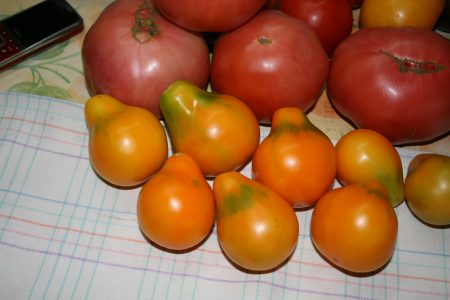
The truffle does not have a specific point when growth ends, so the gardener should look and pinch bushes if necessary. A 2 meter bush is enough, so that later you do not collect your crop with a large staircase, like a vineyard.
The rest of the "Japanese truffle" does not have special varietal properties, it needs standard tomato care. Watering, regular loosening, then airing (for plants inside greenhouses), inspection, top dressing.
The description should be supplemented by the resistance of the "Japanese truffle" to sudden cold weather, as well as to unpleasant fungal diseases, for example, late blight - a real pest tomato.
If we talk about the name, it is unlikely that the truffle has any even the slightest relation to Japan. Perhaps the inventor of the variety was inspired by the unusual shape of the tomato. Although, hence its name "truffle". True, some compare such tomatoes with a pear or a bulb, with a pumpkin (there are pear-shaped pumpkins).
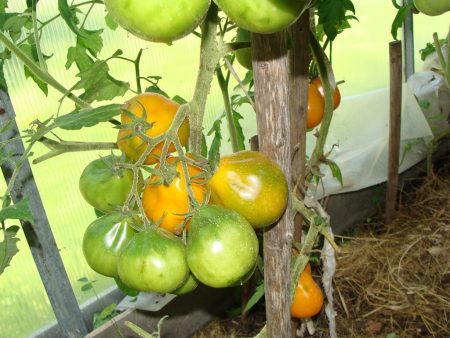
To grow tomatoes fully on the ground or in the greenhouse, first form the seedlings separately, only then transplant it. Usually, the time for planting falls in May, but an experienced gardener begins preparation from the end of winter.
After all, the site needs to be cleared, to give the Sun more opportunity to warm the soil. Then think about feeding, choose a place for seedlings. Indeed, in addition to tomatoes, gardeners plant potatoes, cucumbers, pumpkin, a lot of things. For each type of vegetable garden divided into sectors. Who remembers grandmother’s garden, green bushes with potatoes always occupied more space, it ripened later, so it pleased the eye in orderly rows all summer. Tomatoes with cucumbers yield much faster. Japanese Truffle is no exception.
Briefly about the varieties
Red truffle - more often recruited just for conservation, has an extremely pleasant acidity, coupled with a beautiful red tint. Any hostess will like it. However, a beautiful salad comes out of the tomato, seasoning.
Black truffle - of course, really rich black fruits are rare. More often it is purple, or dark red, dark blue shades. It has an extremely rich taste, coupled with an unusual shape and color, especially attracts gourmets and professional chefs.
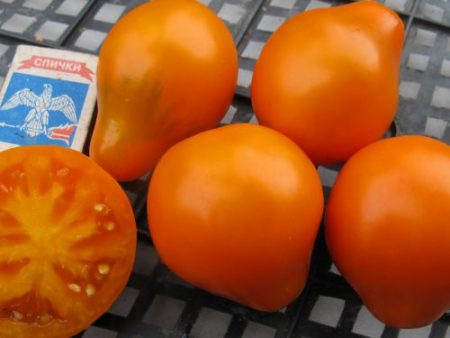
Pink truffle is a beautiful, delicate pink color, tastes more like a red fellow.
Golden truffle - it has a rich, even noble shade, the opinion of gourmets is a sweeter taste.
Orange truffle is a bright, even sunny color, it tastes more like a red fellow.
If you look at the description from practitioners who tried to grow different varieties, then the truffle turns yellow, the sweeter it will be. True, if you make yellow adjika, your home will not immediately decide to eat it. Not to mention the guests! After all, as you know, the outside and the vegetable are inside. The colors of the pulp of the tomato are the same with the coloring of their outer side.
Output
"Japanese Truffle" is undoubtedly a beautiful, delicious variety, taking its original form. By the degree of care, it does not require special expenses (if you look at how to care for tomatoes in general). Great thing for conservation, daily use.Special fans are ready to eat it even like that, instead of fruits. Undoubtedly useful. Of course, most gardeners complain that a good harvest is not worth the wait, so when choosing a truffle, you need to tune in to the average result in advance.
Reviews
Olesya
“Indeed, a beautiful tomato, I really liked it. True, I didn’t grow it, I took a few kilograms for rolling for a sample. It was the form that attracted. I tried it before sunset, delicious. "Golden sweets, the saleswoman herself advised taking several varieties, they say in the bank they will then look prettier."

Anna
“Do you need to spud?” I am used to cultivating beds constantly, I like it when it is clean, the excess weed does not grow. I read somewhere that some tomato varieties love the "company" from other plants. Which ones? The “truffle” doesn’t say anything like this ”
Recommended:How to grow tomatoes according to the method of Maslov
Irina
"Not necessary. Of course, it is worth hilling up when the sprouts are still small and the seedlings only take root. Then, when the bushes are already a meter or higher, try hard, not worth it. Regular watering, top dressing, monitor the condition of the bushes. Maybe he tolerates most diseases, but no one has canceled the pests so far. No wonder they say an attentive owner gets a good harvest. Moreover, the "truffle" of abundance does not promise. I like the variety itself, the tomatoes are beautiful, tasty, especially the children like it. We are planting now, the third year. This year there will also be a “truffle”. I wonder why he was called Japanese? ”




 Low-growing tomatoes, without pinching: 5 of the most delicious varieties
Low-growing tomatoes, without pinching: 5 of the most delicious varieties Why tomato seedlings grow poorly
Why tomato seedlings grow poorly We grow a tomato in a shell
We grow a tomato in a shell Growing tomatoes without watering according to the method of Kazarin
Growing tomatoes without watering according to the method of Kazarin